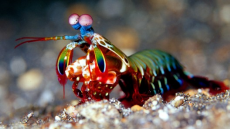
The mantis shrimp, or stomatopod, is a type of marine crustacean. There are more than 450 species of Mantis shrimp, which are typically 10 centimetres (3.9 in) in length, though a few species reach up to 38 cm (15 in). Although some live in temperate seas, most species live in tropical and subtropical waters in the Indian and Pacific Oceans between eastern Africa and Hawaii. They are aggressive and solitary creatures, spending most of their time hiding in rock formations, or burrowing into the sea bed. They rarely leave their homes except to feed; unlike most crustaceans they hunt, chase and kill their prey.
Mantis shrimp live for a long time, and exhibit complex behaviour, such as ritualised fighting. Some species use fluorescent patterns on their bodies for signalling with each other, particularly during mating. In a lifetime, they may breed as many as 20 or 30 times. Depending on the species, the eggs can be laid and kept in a burrow, or they can be carried around under the female's tail until they hatch. Also depending on the species, the male and female may come together only to mate, or they may bond in monogamous long-term relationships. In the monogamous species, the mantis shrimp remain with the same partner for up to 20 years, with both sexes taking care of the eggs.
These crustaceans are commonly separated into two groups depending on the type of claws they possess. Smashers have a much more developed club and a more rudimentary spear, with the club used to smash their meals apart. Smashers use this ability to attack snails, crabs, molluscs and rock oysters, their blunt clubs enabling them to crack the shells of their prey into pieces. Spearers, on the other hand, are armed with spiny appendages topped with barbed tips, used to stab and snag prey. Spearers prefer the meat of softer animals, like fish, which their barbed claws can more easily tear at. The shrimp use their weapons with blinding quickness, with speeds of 23 m/s from a standing start. Because they strike so rapidly, they produce bubbles between their claws and their prey; the collapse of these bubbles produces additional force on top of the 1,500 newtons delivered by the first blow. Even if the initial strike misses the prey, the resulting shock wave can be enough to stun or kill them.
The mantis shrimp has one of the most elaborate visual systems ever discovered. Their eyes carry 16 types of colour-receptive cones, compared to the three types that humans possess. This gives the crustacean the ability to recognize colours that are unimaginable to other species. Their eyes enable them to recognize different types of coral, prey which are often transparent, and predators, such as barracuda, which have shimmering scales. The very rapid way that the mantis shrimp hunts requires accurate information and depth perception.
Sometimes mantis shrimp are kept in captivity, with such species as the peacock mantis particular desired due to their beautiful colours. However, they are risky pets. Voracious predators, they will eat any other inhabitants of their tanks, and even when kept alone are capable of breaking aquarium glass with their powerful claws! Mantis shrimp are enjoyed as part of Mediterrean cuisine, in Hawaii and throughout Asia. In Japanese cuisine, the mantis shrimp species Oratosquilla oratoria is eaten boiled as a sushi topping, and occasionally, raw as sashimi. Mantis shrimp are abundant in the coastal regions of south Vietnam, known in Vietnamese as tôm tít or tôm tích. The shrimp can be steamed, boiled, grilled or dried; used with pepper, salt, and lime; fish sauce and tamarind; or fennel.
Image: http://nycda.zone/feldman607/mantisshrimp/mantispic.jpg

0 Comment:
Be the first one to comment on this article.